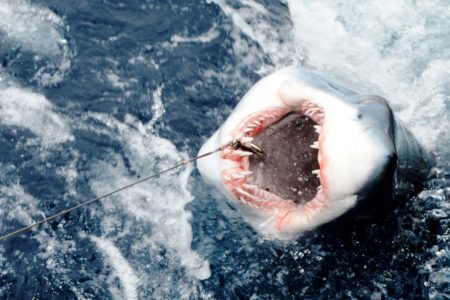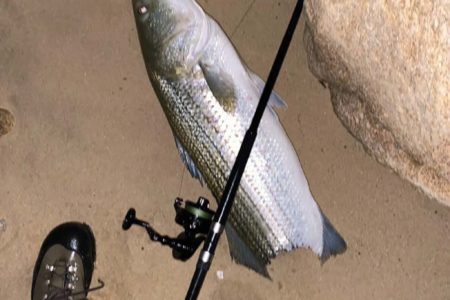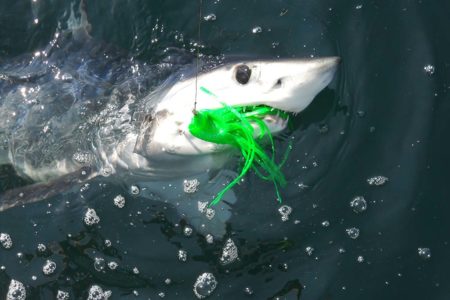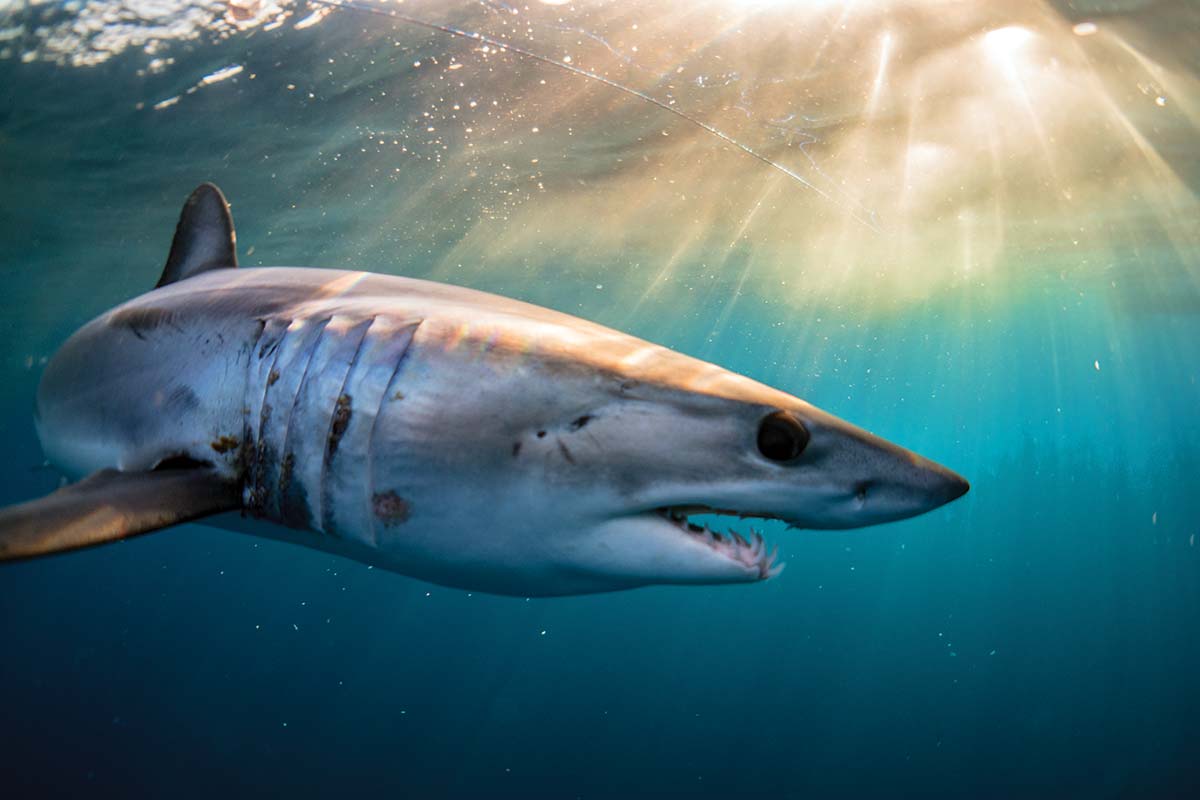
Why is the public falling in love with sharks?
Public perceptions often change over time, but the most unusual I’ve noted over my lifetime has been the recent infatuation with sharks. From being widely regarded as a menacing danger to human beings, they are now being recognized by many as necessary for healthy oceans. Furthermore, the federal government is spending a lot of money to build up populations of great white sharks – “maneaters” – which are completely protected and often fitted with satellite tags and given names so the public can follow their movements.
Older readers and Jaws fans know the story of the heavy cruiser Indianapolis (CA35) sunk by torpedoes fired by a Japanese sub just before the end of WW II. Of the 1,186 men aboard, only 317 survived after days in Philippine Sea waters – and many of them fell victim to attacks by oceanic whitetip sharks. That incident was cited as the reason for Quint’s hatred of sharks in Jaws, although whitetips are now protected by internationally by the International Commission for the Conservation of Atlantic Tunas (ICCAT) even though they are a low value species – except for their fins – and also of no interest to anglers
I once caught a whitetip that ate a snapper I had jigged at Hannibal Bank off Panama on heavy baitcasting tackle (Ambassadeur 7000 and musky rod) and it fought like a lazy nurse shark. Though it’s very unlikely you’ll ever encounter a whitetip unless you’re wrecked at sea, bull sharks are another consideration inshore in the tropics at all times. Back in June, social media was atwitter with video of a Florida fisherman in the Everglades getting pulled into the water by what experts believe to be a bull shark which chomped on to the man’s arm while he was washing his hands off the side of a boat.
Such attacks aren’t very uncommon in those waters due to the volume of people present and the fact that the bull is a very aggressive shark which prefers shallow waters and often moves well up into rivers. The deadly Lake Nicaragua shark is just a bull which has acclimated to a completely freshwater environment. Yet, when a tournament organizer set up a bull shark contest in south Florida last year it was met with such a public outcry that the weigh-ins had to be made at a residential home even though it was primarily a tagging event.
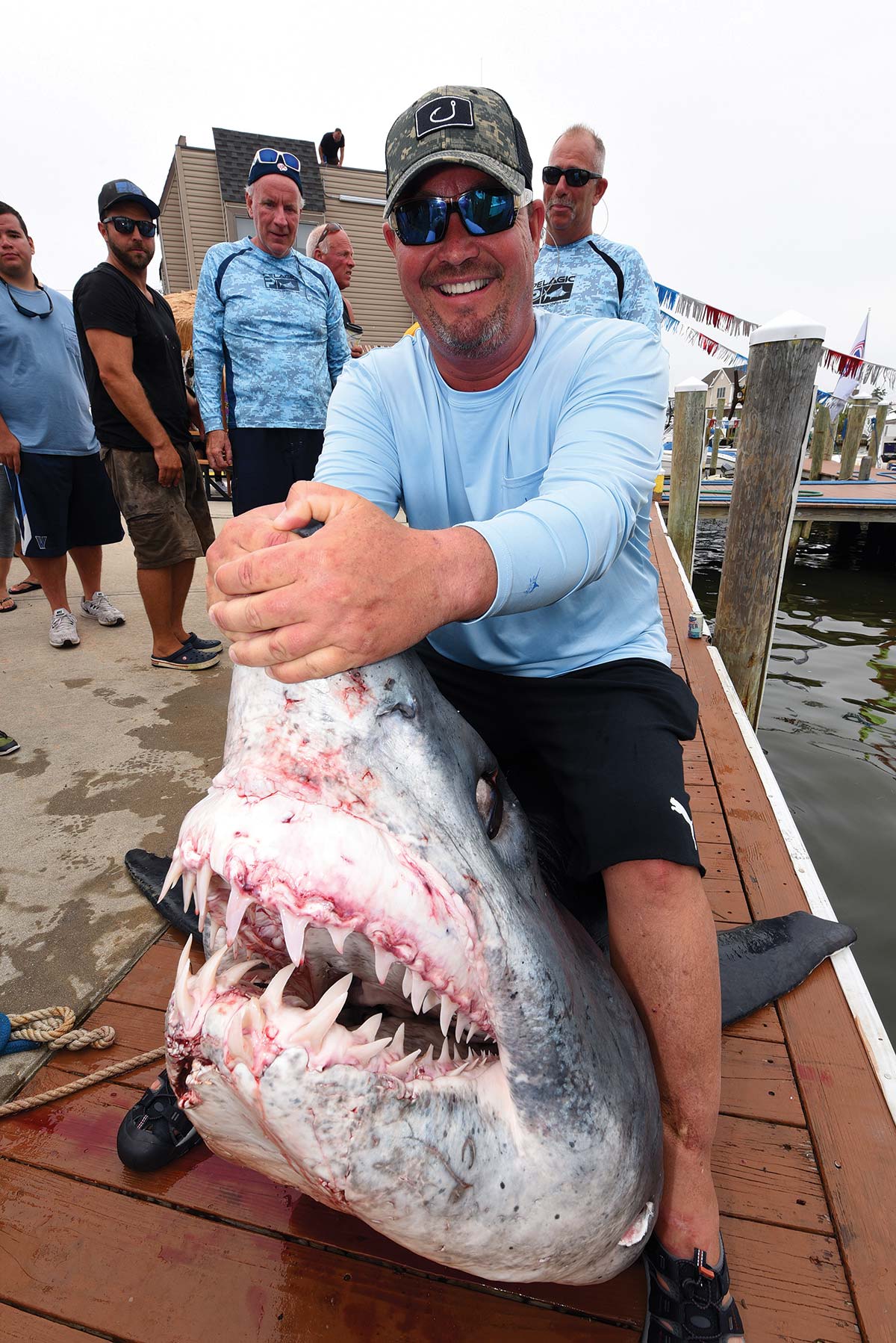
Hype & Headlines
Most commercial fishermen have been trying to eliminate the spiny dogfish for ages due to their interference with fishing for cod and other valuable bottom fish, though with very little success. Spinies also prey on the young of other species, including depleted populations being managed to recovery. Spiny dogfish are very popular in Europe where they’ve been overfished. That eventually resulted in development of an export fishery on the east coast, until environmental groups objected to that fishery and cited a National Marine Fisheries Service (NMFS) study showing a declining female spawning stock as a reason to sharply lower the catch.
At that time I ran a bluefish charter out of Manasquan Inlet at the Jersey Shore in the summer during which my anglers weren’t able to get through the normally bottom hugging dogfish with baits floated astern on the surface (something I’d never seen before) and all the dogfish were large females. I checked with the party boat skippers fishing there, and found they were also catching female dogfish. As my father used to say “Statistics don’t lie, but statisticians do.”
Ironically, just before starting to write this article, I opened the internet to find a feature entitled “Why Sharks Are Absolutely Necessary To Our Existence.” It notes “Sharks have a really bad reputation because occasionally they attack humans. However, sharks rarely attack our kind unless they smell blood. Moreover, when sharks are hungry they become angry, and therefore are more likely to be aggressive. It is humans who are responsible for diminishing the food available to them through excessive fishing.”
My guess is that writer must have had a hard time interviewing sharks in order to determine their state of mind!
Another internet post I found was from a woman who was worried about there not being enough sharks left to keep our waters “clean”. That seems to reflect a common misconception that the ocean is full of dead and dying fish that sharks must eat as if they are underwater vacuum cleaners. Predator-prey relationships are much more complex than that and can change depending on what is available.
The only positive I’m aware of is the fact that large sharks often feed on dead whales, which of course has become another Atlantic Coast controversy in recent months making national headlines.
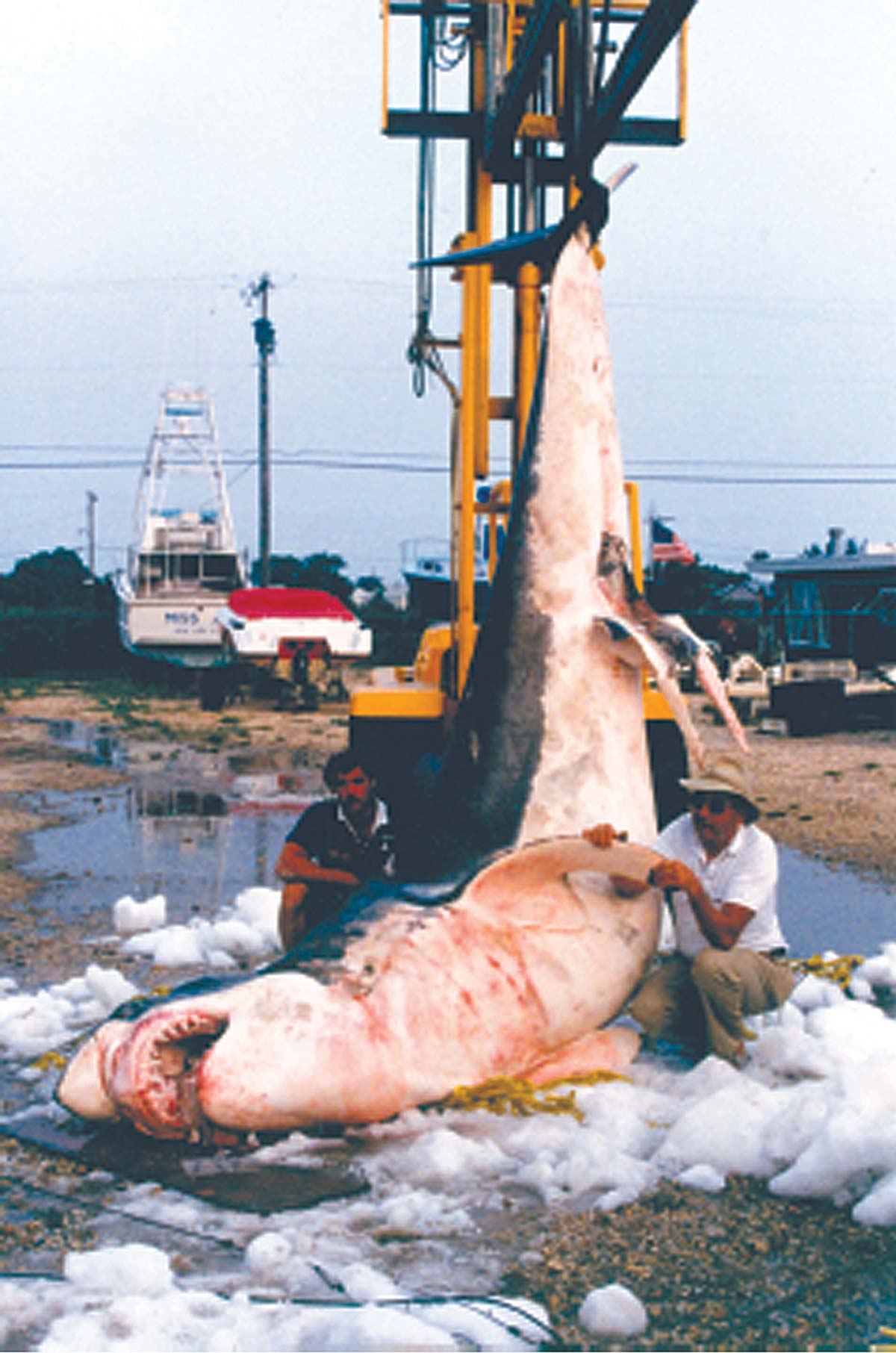
Management & Uncertainty
Sharks are frequently referred to as apex predators, but I dare say it’s actually human beings who are the real apex predator. As such we can greatly influence the abundance of species through regulation. Unfortunately, such results are more difficult with sharks that are generally long-lived, but slow growing while producing only a few live offspring. It’s always amazed me that makos could stand up to all the recreational and longlining pressure on them in view of the fact that both male and female have to be huge before becoming mature — making it impractical to set a reasonable minimum without ignoring the basic concept of allowing each fish to spawn at least once before harvest.
As a member of the original Mid-Atlantic Fishery Management Council, I fought for a shark management plan that wasn’t high on the agenda full of important food and game species. Though the Magnuson Stevens Act calls for every species to be managed, we had so little information about the larger sharks that it seemed more practical to consider them all in a single plan in order to bring scientists and both sport and commercial fishermen together for planning.
During those discussions, I met with longliners who surprised me with accounts of all the makos they were longlining off North Carolina in the winter. I also attempted to get some voluntary concessions on mako minimum sizes from the longliners. There was no consideration of spawning size, but only marketable size. Therefore, we were talking about figures such as 20 pounds — and even that was unacceptable.
I have a long love-hate relationship with sharks. During my formative years, getting the opportunity to catch a large offshore game fish was a dream, and the first blue shark was appreciated. Those “maneaters” were brought in, weighed and then dumped back in the ocean as the boaters I fished with felt they were doing the public a favor by eliminating them. Yet it soon became apparent that blue sharks were harmless and killing a fish of poor eating quality was a waste.
Fortunately, Jack Casey developed his shark tagging program out of the Sandy Hook Marine Lab in 1963 which transformed the fishery to one in which conservation was the standard, and usually only makos were retained. Frank Mather had started bluefin tuna tagging out of the Woods Hole lab in Massachusetts which proved that species was being severely overfished. Casey modified Mather’s tag for use in sharks, and started with about 100 volunteer recreational and commercial fishermen. I did all I could to get fellow anglers into the program as I began my writing and chartering careers with an emphasis on “The poor man’s big game fishing.” Hundreds of blue and sandbar (brown) sharks were tagged and returns came in regularly, topped by a mako I tagged off New Jersey that was recaptured in Mexico.
On the other hand, when I started traveling to Panama there was a shark problem. During the rainy season wahoo trolling it was a race to get a hooked wahoo in before a shark either ate or mutilated it. The best casting area near Club Pacifico was at a large underwater rock where the first cast with a pencil popper would bring up a mass of mullet and cubera snapper which turned the water red as they competed along with jacks and trevally for the plug. Yet, only a couple of what I called the red horde might be boated before sharks would nail every one during the fight and we’d be forced to leave.
After Club Pacifico was closed, it was a few years before we could return to the area on a mothership. In the meantime there had been a commercial shark fishery based out of David. The same underwater rock produced some fish for us, but there wasn’t a single one lost to a shark! Indeed, I never encountered a shark on that trip or on any other since. That was far from the first time intensive longlining had wiped out a shark population. Samuel Gruber edited a 1990 American Littoral Society book called Discovering Sharks in which he detailed the sad story of the porbeagle shark that was virtually swept from the seas in just seven years.
“In the late 1950s, Italians considered porbeagle flesh a gourmet delight and were willing to pay exorbitant prices for it. Norwegian fishermen, familiar with the species habits were more than happy to reap this windfall. In 1961 the uncontrolled exploitation began and about 3,500,000 pounds were caught. The catch quickly peaked only three years later at 16 million pounds, then crashed. By 1968 only a few hundred sharks could be found.”
To this day, porbeagles remain scarce, though a few may be caught at Cox’s Ledge and in other New England waters.
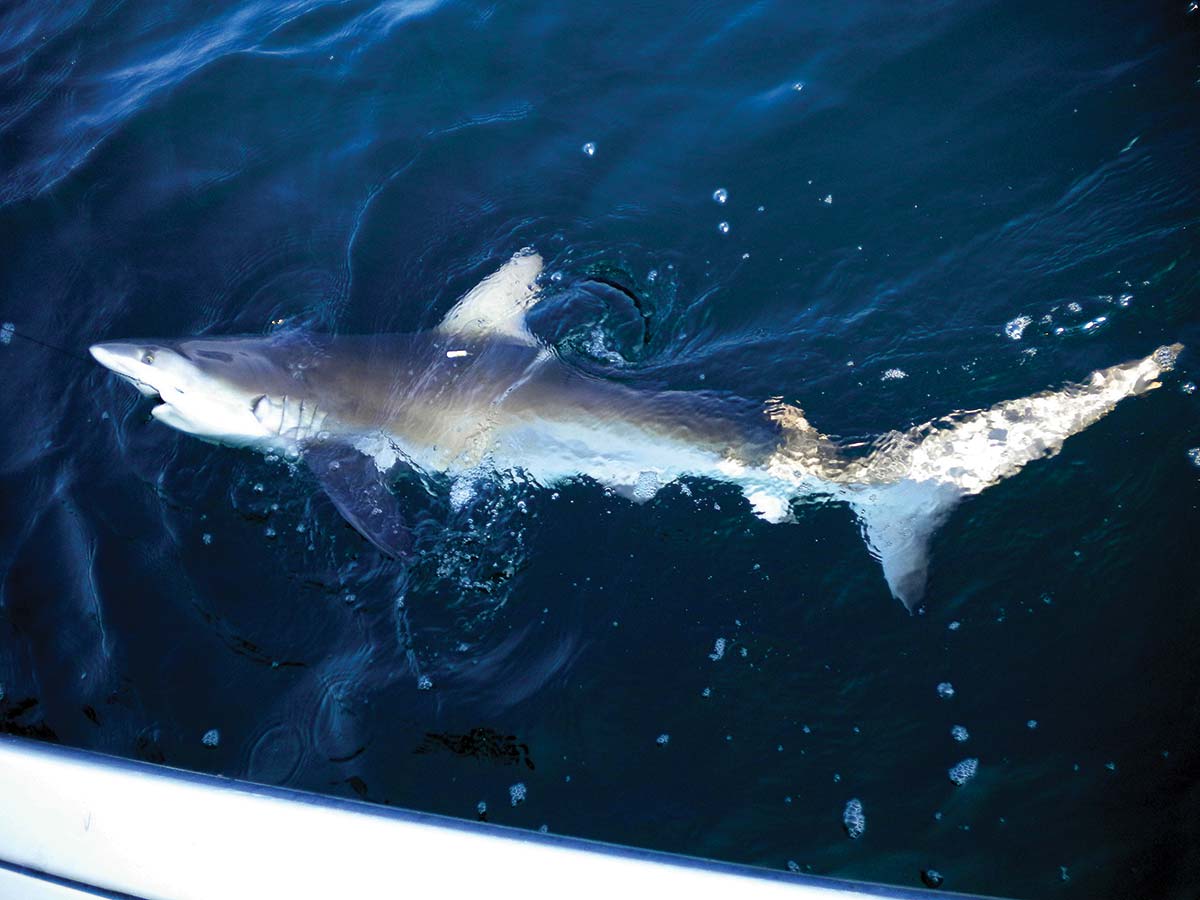
Then & Now
Shark fishing was much different in the waters I started fishing for them off the south shore of Long Island, primarily with Jesse York of Atlantic Beach on his Compass Rose. We caught blues and sandbars regularly plus an occasional small hammerhead, dusky or tiger, while never seeing a white. There were no threshers or porbeagles. It should be noted that sharking then usually involved only a 10- to 20-mile run offshore with no attention paid to structure. There were few bunker inshore to attract threshers as is now the case. Makos weren’t abundant, though we usually managed one or two.
It was a big surprise when Jack Casey informed me that the Sandy Hook Lab had fished a longline in Sandy Hook Channel that produced10 juvenile white sharks, but he didn’t want that publicized for fear of affecting the Jersey Shore tourist business where memories of white shark attacks in the surf during the 1950s hadn’t faded from memory.
There seemed to be no thought of white sharks in Massachusetts before Jaws. I trailered my Mako 18 up to Cape Cod for stripers in the Monomoy area and would have been thrilled to sight a seal. However, I never did until a couple of decades later when the beaches were covered with them. Now they’ve become land-based chum for white sharks, having ignored climate change predictions and movING south in great quantities instead of moving north to colder waters
Montauk was a sharking paradise with deeper waters closer to shore and Capt. Frank Mundus would prove that point every winter with his booth full of shark jaws and teeth at the old New York Sportsman’s Show. After moving my Mako out there I finally saw a thresher at the docks, but whites remained very unusual even though they were still legal to catch. I’ve never seen a white in my shark slicks anywhere, but have seen them three times while tuna fishing.
While the public worries about overfishing of sharks, most anglers and charter boat captains usually have a very different perspective. It’s unusual for them to encourage a commercial fishery, but that’s not the case with sharks which have become almost impossible to fish through in many areas. Florida guides have an especially difficult time getting snappers, groupers and other food and game fish up through the water column before sharks grab them. That problem is diminished when commercial shark fisheries are allowed to operate.
During many years of northern tuna fishing I never had a shark problem until one day around Barnegat Ridge when I had a barely legal bluefin alongside. A very small mako appeared and promptly snipped off its tail. It was many years later before a most unusual early season school bluefin run off the north Jersey coast in 2020 when sharks were ravenous. Chuck Many chartered Fisher Price IV from Highlands and immediately hooked a bluefin on a popper which changed into a shark by the time he got it to the boat.
Those sharks (which appeared to be duskys) were so fierce that they even hit poppers directly. When we switched to trolling heavy tackle it was more of the same. Capt. Derek Belitz was shouting at us to reel faster, but that couldn’t be done with the boat in gear and both tuna and sharks on the other end. Several very expensive sidetracker rigs were lost in order to get a tuna in the boat. Yet, surprisingly, there was a great offshore chunking run of yellowfin tuna that summer with no interference by sharks at all.
| SHARKED ACT |
| In June, U.S. Representatives Rob Wittman (R-VA), Darren Soto (D-FL), Garret Graves (R-LA) and Marc Veasey (D-TX) introduced the Supporting the Health of Aquatic systems through Research, Knowledge and Enhanced Dialogue (SHARKED) Act in the U.S. House of Representatives. The legislation would address the increasing challenge of shark depredation by establishing a task force comprised of fisheries managers and shark experts to improve coordination and communication across the fisheries management community on shark depredation. |
That’s the way it is with sharks. During the years when I did a lot of billfishing in the Pacific I often worried about sharks attacking billfish and tuna during battles lasting up to 21 hours, but it never happened. On the other hand, my nephew, Todd Correll of Ft. Lauderdale says it’s almost impossible to troll a yellowfin tuna in some areas of the Bahamas because sharks hit them immediately. He and fellow skippers are convinced that sharks there have learned to react to the sound change as speed is reduced after hook-ups.
Sharks are far from the most numerous fish in the seas, but they are among the most indestructible. The statistics involving millions of sharks caught throughout the world’s oceans are a caution. Yet, the generally low value of their flesh (except for makos, threshers and porbeagles) provides a great deal of protection, while both national and international regulations create a safety net that should ensure overexploitation doesn’t occur again.
If all we have to worry about in marine conservation is whether there are “enough” sharks, I suspect there are very good days ahead.

